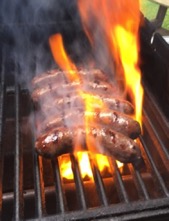Heat
Heat and the Destruction of Gluten

This question has been asked countless times over the years. Until now, we have not had any concrete answers.
All too often the gluten-free community runs into restaurants using the same deep frier for gluten items and their gluten-free items. Of course, we know this practice is not acceptable for those requiring truly gluten-free foods, but the uneducated think otherwise.
This study appearing at the International Celiac Symposium 2017 India, shows it's quite difficult to destroy gluten with temperatures used in customary cooking methods. And when it is destroyed, it's not safe to eat [not that gluten is safe to eat in its uncarbonized state...]
Resistance of gluten immunogenic peptides (GIP) to heat elimination in a homelike environment. Lessons for cross contamination prevention.
Rodriguez Herrera A2, Garcia Sanchez M2, Lamprea Moruno M2, Monje J3, Comino I1
1 Facultad de Farmacia, Spain, 2 IHP Group, Spain, 3 Universidad Pablo de Olavide, Spain
Background
Verify effective elimination of Gluten Immunogenic Peptides (GIP) by home cooking techniques.
Methods
Batches of samples of gluten containing flour, potatoes, and potatoes plus flour matched to controls were tested. Each batch was cooked in laboratory by use of electric stove, gas stove, oil deep fryer, induction stove and water bath and was cooked at temperature range from 91-233°C (196-452 F) for 5 up to 30 minutes. GIP content was tested by GlutenTox® Sticks (KT- 5340 Biomedal Diagnostics) based on antibody G12.
Results
On gas stove was necessary to keep 233 °C (451 °F) for 10 minutes to have absence of GIP detection.
In range 190-200°C (374-392°F) incubation for 30 minutes was needed to have absence of GIP detection. Tests in temperatures below 190°C (374°F) showed presence of GIP at 10 and 20 minutes.
On induction stove temperature up to 246°C (475°F) for 6 minutes was needed to have negativity to GIP.
Lower temperature ranges in spite of extended time up to 30 minutes were unable to get negative GIP. In oven processing never was got negative GIP signal, in spite of processing up to 210°C (410°F) and extended incubation time up to 45 minutes.
Samples processed on electric stove, water bath and deep frying showed presence of GIP in all ranges of time and temperature.
Conclusion
It is not realistic the elimination of gluten (GIP) at home kitchen by heat as temperatures higher that 200°C (392°F) are needed. Extended processing time is no compatible with conventional recipes. Fat processing over 200 is link with toxic metabolites generation which may be harmful. Use of oven or deep frying without proper cleaning may transfer GIP to meals when previously gluten containing meals were processed in these appliances.
Rodriguez Herrera A2, Garcia Sanchez M2, Lamprea Moruno M2, Monje J3, Comino I1
1 Facultad de Farmacia, Spain, 2 IHP Group, Spain, 3 Universidad Pablo de Olavide, Spain
Background
Verify effective elimination of Gluten Immunogenic Peptides (GIP) by home cooking techniques.
Methods
Batches of samples of gluten containing flour, potatoes, and potatoes plus flour matched to controls were tested. Each batch was cooked in laboratory by use of electric stove, gas stove, oil deep fryer, induction stove and water bath and was cooked at temperature range from 91-233°C (196-452 F) for 5 up to 30 minutes. GIP content was tested by GlutenTox® Sticks (KT- 5340 Biomedal Diagnostics) based on antibody G12.
Results
On gas stove was necessary to keep 233 °C (451 °F) for 10 minutes to have absence of GIP detection.
In range 190-200°C (374-392°F) incubation for 30 minutes was needed to have absence of GIP detection. Tests in temperatures below 190°C (374°F) showed presence of GIP at 10 and 20 minutes.
On induction stove temperature up to 246°C (475°F) for 6 minutes was needed to have negativity to GIP.
Lower temperature ranges in spite of extended time up to 30 minutes were unable to get negative GIP. In oven processing never was got negative GIP signal, in spite of processing up to 210°C (410°F) and extended incubation time up to 45 minutes.
Samples processed on electric stove, water bath and deep frying showed presence of GIP in all ranges of time and temperature.
Conclusion
It is not realistic the elimination of gluten (GIP) at home kitchen by heat as temperatures higher that 200°C (392°F) are needed. Extended processing time is no compatible with conventional recipes. Fat processing over 200 is link with toxic metabolites generation which may be harmful. Use of oven or deep frying without proper cleaning may transfer GIP to meals when previously gluten containing meals were processed in these appliances.
Source: http://bit.ly/2CevzOY